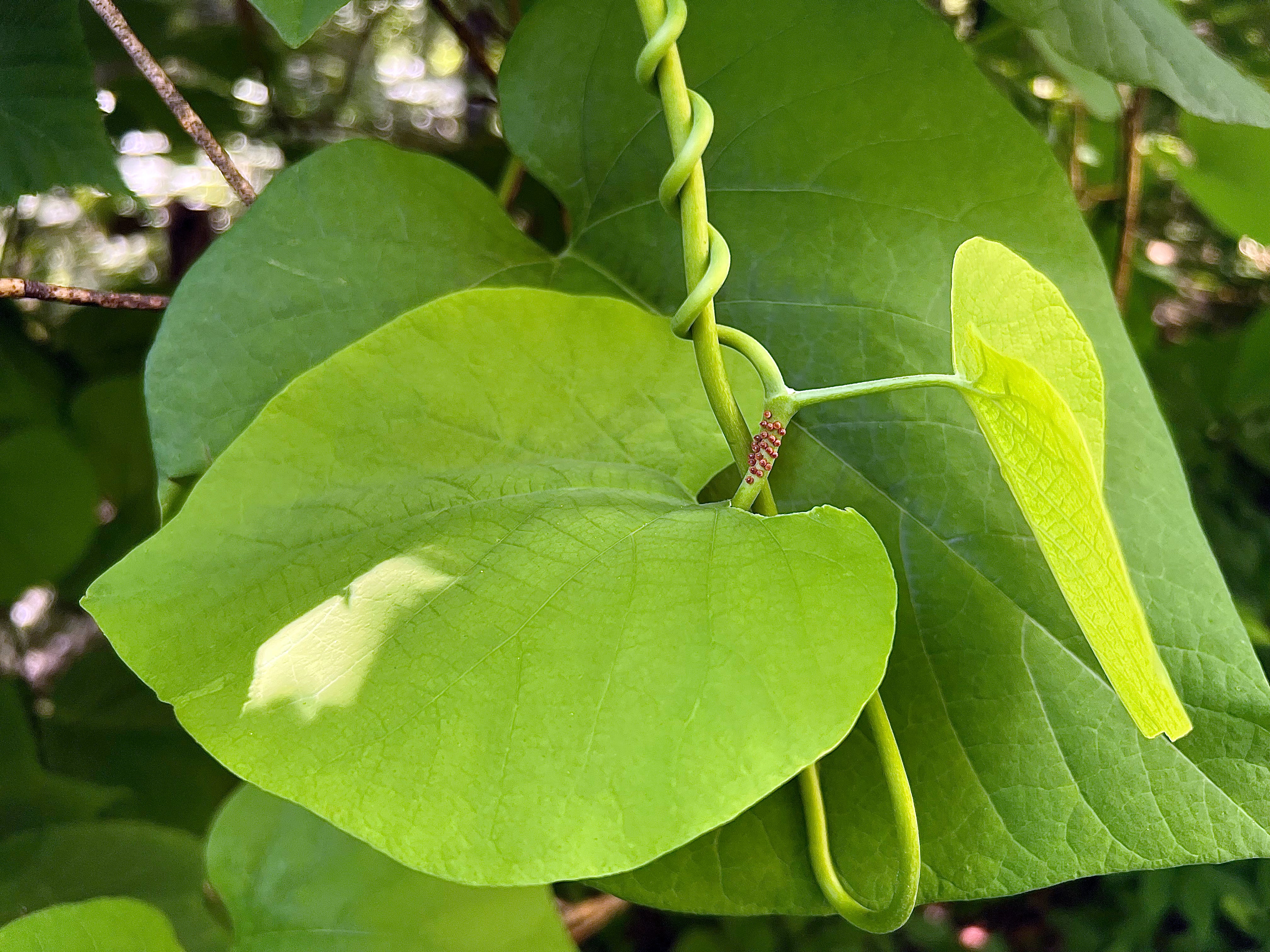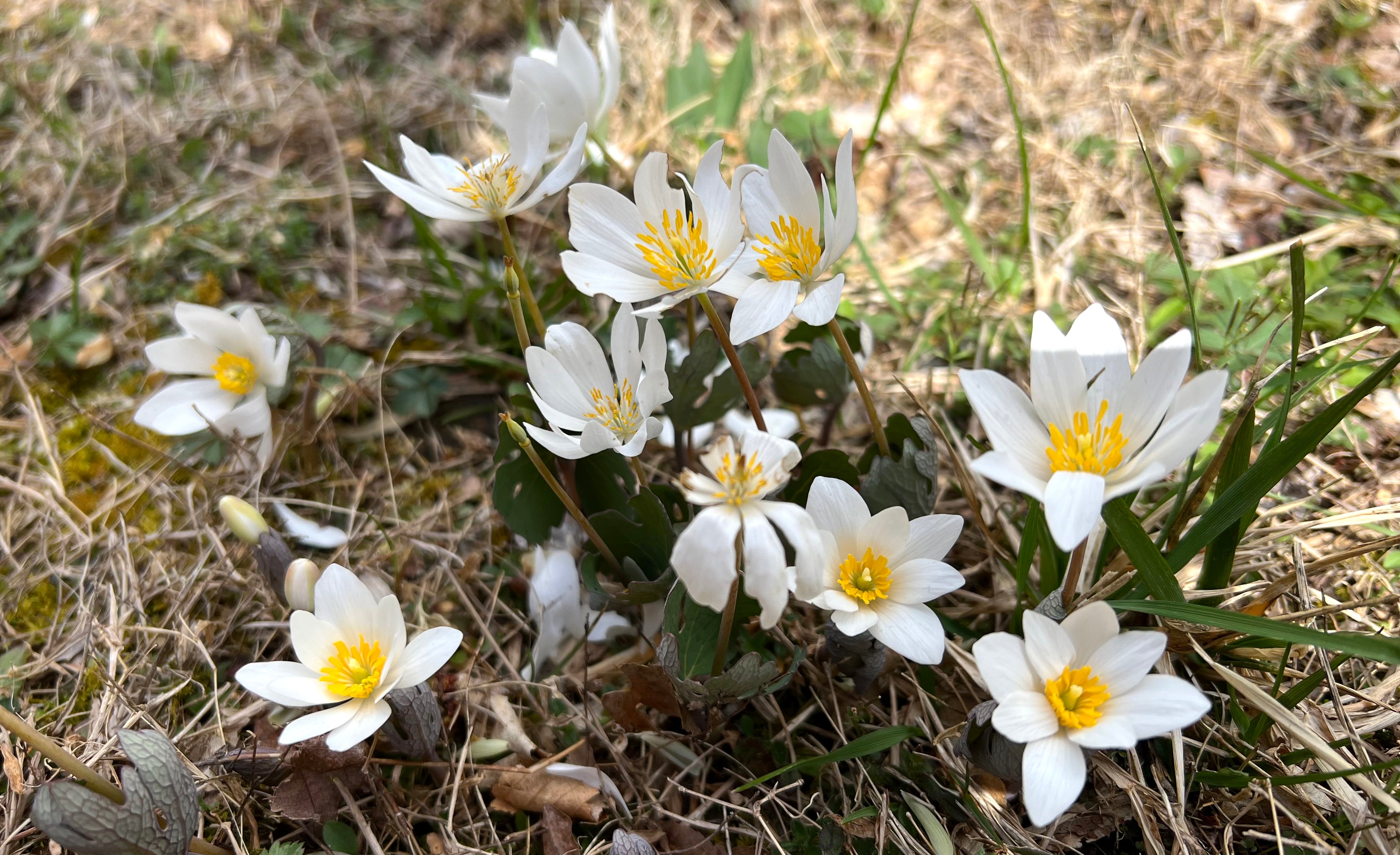
Birthwort & the Present Moment
I alternate between using two different names for the plants in this family: originally called Birthwort, they also became well-known as Dutchman’s Pipe. Both names reference the odd shape of the flower, and also hint at the relationship between humans and these plants.
This is an old plant with a rich history of use. The first record dates back to 400 AD in Ayurvedic and Chinese medicine texts, where it was used for skin ailments, clearing the lungs, and improving digestion. In Ancient Egypt, it was the go-to remedy for snake bites, with its name reading as “anti-snake” when translated. It was used in Greek and Roman Europe to expedite childbirth and to release the placenta after delivery. Indigenous people in the Appalachians used it when someone had fevers or bad dreams. I get particularly excited when a plant has such a wide range of habitat and uses in the world, because it indicates a depth and complexity that we are probably only scratching the surface of.
But despite its long medicinal history, it has been removed from western medicine. Birthwort contains aristolochic acid, which been found in the 1950s to to be a poisonous carcinogenic. Urological cancer and kidney failure are the most common toxic effects. Consequently, this plant has fallen out of favor and largely out of the public eye.

I work with a type of Birthwort in Appalachia called Aristolochia macrophylla, also sometimes known as Aristolochia durior. It’s a vigorous vining plant with giant heart-shaped leaves that spread out and create a fast shade canopy. Its small flowers tend to shy away from attention, hiding underneath. Part of the reason the flowers manage to blend in so well is because they grow directly below the massive leaves. But it’s also because they don’t really look like flowers - they look almost like a hanging mushroom. Attached to the vine is a thick, fleshy tube that bows down into a “U” shape, with the triangular flower opening at the other tend. In the middle of the flower is a surprisingly bright yellow center that opens deep into the tube. The inner part of the tube remains a mystery, since the curve prevents the eye from seeing in. They look bizarre and not much like the inviting flowers we are used to.
They are inviting to a particular member of the animal kingdom, though: the Pipevine Swallowtail caterpillar and butterfly. This caterpillar has evolved with Birthwort to become one of the few creatures that can eat it with no negative side effects. It also stores the chemical compounds of the plant in its body, even through metamorphosis, to pass along the toxicity to any potential predators of the butterfly. Naturally, this strong of an interspecies bond means that Pipevine Swallowtails only lay their eggs on this plant for protection. If you see a beautiful blue and black butterfly with orange dots under its wings, it’s a good sign that Birthwort is in your general area.

One of the primary themes I see come up with Birthwort on a spirit level is the individual connection to the greater whole, often within the cycles of life. Vining plants in general are good reminders of interconnectedness. They start from a single point in the ground, growing tall only with the assistance of nearby plants or structures. They can’t go upwards alone. Their flexible stems branch and curl and adjust as needed, stretching out in all directions and sending forth a seemingly endless amount of leaves. Although made up of the small singular parts, prolific vining plants can become so dense that it’s difficult to see where one part begins and another ends. Separating the vines becomes impossible. This is very similar to one person’s position in all of humanity and how we all rely on each other.
This specific vining plant has more to add, though. Deeper lessons are hinted at with its historic medicinal use in childbirth and with the lifecycle of the Pipevine Swallowtail. Both the human womb and the butterfly chrysalis are incubators to prepare something for the next phase of its existence, safely tucked away just like the Birthwort flower under the leaves. They are structures that offer protection for the changes that naturally occur, and they look similar to the unusual structure of the flower. This could be why the spirit of this plant is so supportive for transitional phases in someone’s lifetime. It has the interconnected wisdom of a vining plant with its own unique voice to protect, ground, and assist in moving through something.
There’s a lot of fear going into any transition; you’re leaving behind the familiar and entering into new territory. And often during the intense, transitional times, people either cling to the past or keep their eyes laser-focused ahead. It’s much harder to remain grounded in the present when things are in flux and you feel like the floor is moving beneath you. Birthwort can remind you: it doesn’t matter where you’re going next, all that you have is this moment right now. Do not forget to tend to yourself as you are. Stay present as things change. This moment is all moments.
“When you touch the present moment, you touch the past and the future. When you touch time, you touch space. When you touch space, you touch time.” Thich Nhat Hanh
While Birthwort can assist the spirit in moving through any phases of change, I think it shines with the major physical transitions that everyone goes through: birth and death. The transition of leaving the womb and being born into this world is a natural association, as evidenced by the name of this plant and its historic uses. But I would like to suggest that it is also skilled at moving one’s spirit through the transition of life into death. Any time there is a physical threshold to cross, this plant does excellent work in grounding and guiding. Since death is one of the greatest mysteries of life and thus one of the biggest fears, it is hard to stay present for. Sometimes people respond to this with control, panic, or even denial that death will come at all. The spirit of Birthwort can re-align someone with the present moment to go through the transition with clarity and a sense of greater connection to themselves and to the collective.
I would urge you to explore this plant through the lens of your own beliefs of what happens after death. What comes after the transition and what is needed of you right now? If you believe in reincarnation, try sitting with this plant during past life recall. If you take a more meditative approach in that there is no ending or beginning, spend time with this plant during contemplation. If you favor a more structured religious worldview, let this plant come into your consciousness while praying or asking for guidance. If your perspective is that nothing happens after we die and we simply stop, let this plant assist in staying present while you are here. Although Birthwort always keeps a holistic viewpoint, the insight that it offers is very unique to the individual.
I’d like to also bring in the name Dutchman’s Pipe again, because there is also an aspect to spirit work with this plant revolving around the throat and using one’s individual voice. There is a reminder to be solid in who you are, where you are in life, and what you have to offer. Coughing is common when working energetically with it, as if clearing any blockages that would impede someone from speaking up. Use your voice, it’s needed, you are valid and a part of this world. There is no one identical to you, and it’s each unique voice that builds the collective of humanity.
This plant has a unique perspective, and like any poison plant, offers some deep guidance on the themes of life that everyone experiences and few talk about. It would be a great friend for someone questioning their place in the bigger picture, both in the scope of their own life and in the context of our species. And it may be one of my top plant spirit recommendations for anyone starting to explore their own mortality and eventual death, and what it means for living more fully in the present moment.

Disclaimer: This article is about working with the energetics of this plant and does not encourage ingesting the actual plant.



